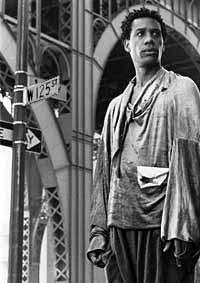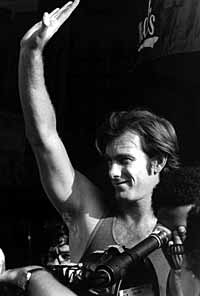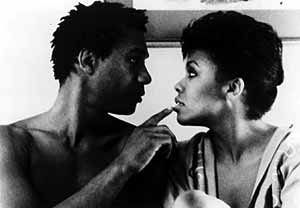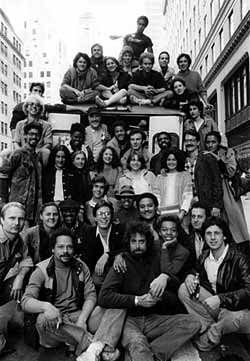 "A very New York story"
"A very New York story"
Joe Morton in The Brother From Another
Planet |
June 6, 2002 | At a seminar hosted
by the Tribeca Film Festival,
filmmaker Martin Scorsese lamented the lack of films
set in Harlem. While it may be true that the storied neighborhood hasn't been
used as a setting much since the 70's (a decade which spawned classic films like Cotton Comes to
Harlem
and Shaft), there has been one important exception: John Sayles' The
Brother From Another Planet (1984). As a story, it's an original. As a cinematic
experience, it's uniquely lyrical. And as a statement of a time and place it is
thoroughly specific. With the film nearing its twentieth anniversary The Brother From Another Planet
deserves another look. Luckily it's getting just
that as newly restored prints will be shown at
theaters across the country as part of a huge John Sayles retrospective,
with the director speaking before Brother in at least one venue. (See below for more
info.) Eventually the
restored version of the film will be released on DVD (along with the other early
Sayles film in the retrospective: Return of the Secaucus Seven, Lianna,
and Matewan), a much needed event given the scarcity and low quality of the old VHS releases and the
semi-bootleg DVD out now.
Brother is the story
of a mute alien (Joe Morton) who crash lands his space ship just off Ellis Island.
He finds his way up to Harlem (he seems to be drawn there unconsciously) where
he is confronted by an interesting dynamic: he looks like he should fit in but
he's obviously very much out of his element. The film takes surprising turns as
the brother learns more and more about this new world, while the parallels between
his own experience and those of his new neighbors —
racism, class struggles, crime, drugs —
become crystal clear through his fresh eyes.
The bold, colorful cinematography by a young Ernest Dickerson and the powerful, subtle performance by Joe
Morton (as well as the rest of the uniformly excellent cast) help the film create a mood and atmosphere
beyond both its budget and the mechanics of its excellent story.
As a science fiction film, The
Brother From Another Planet couldn't be more firmly grounded in reality.
Even among independent
filmmakers, Sayles has been able to maintain a level of independence that no
one else whose films are so regularly distributed can match. Income from screenwriting
has allowed him to at least partially self-finance all of his movies. As Sayles
told Cinema Gotham, "The way that we present things is 'Here's the movie. It's not going
to change much from screenplay to final film. We want final cut, casting control
and business control. Are you interested?' We usually get a very nice quick
no, but sometimes people say yes." Granted, it helps if you can wait a decade
to make your film, as Sayles has done several times.
Still, The Brother From Another Planet
came together in a matter of months, while Sayles regrouped after initial investments in Matewan
fell through. Most helpful in realizing this goal was
the MacArthur grant — the so-called "genius" grant — that Sayles received in
1982. The award of $33,000 a year — tax-free — for five years was what enabled him to make as
seemingly noncommercial a film this one.
Recently Cinema
Gotham had a chance to talk with John Sayles about the film, New York, and
the way they worked together to create a fascinating, unique piece of storytelling.
 John Sayles on the set of Brother
John Sayles on the set of Brother |
Cinema Gotham:
Your films really move around a lot, more than most filmmakers. But they
use the locations as part of the character and essence of the films.
John Sayles:
Well, I've been to all fifty states, spent at least one night in each. I
hitchhiked around the country when I was younger and I think where you live
affects who you are and how you see the world and vice versa, so I do think
that each place has its own character. It's as things get more homogenized
and that shopping mall culture spreads further and further that they're
a little less different than they used to be. There's that thing that sometimes
a place has a real ambience [as well as] an imaginary one, so with a place
like Harlem, it's like Hollywood. You go to a place like Hollywood and Vine
and there's not much there but there's an idea in people's heads of what
Hollywood might be. For me in The Brother From Another Planet, Harlem
was like that too and that's one of the things that was interesting for
me to get into the film. People, and even some of the black people in the
crew, had never been to Harlem, and they had been warned against it from
their parents or whatever, you know. There's that imaginary Harlem that's
iconic and there's that everyday, people-go-to-work-people-go-to-school
Harlem and the tension between the two of those is some of what the movie
was about.
CG: That
actually brings up something I was going to mention. You start the film
with a series of New York icons: Ellis Island, the Statue of Liberty, the
World Trade Center. And then the first thing you see in Harlem is the Cotton
Club and 125th street. His introduction is, he sees the postcard images
and then the more time he spends there the deeper he gets.
JS: Also,
[I did it] for the audience. He doesn't know what these things mean yet
but for the audience its "Oh, he's coming in through Ellis Island," like
so many other immigrants and there's the Statue of Liberty and all these
kind of iconic things that we think of as coming to America. He has no idea
what they are, so you know there's always that thing of whose eyes are you
seeing the world through. There are two tracks of what the
audience's preconceptions are and what they already know, and what I eventually
want to do is get them to see the world through his eyes. So very shortly
after he comes to shore, even though we know what these things are, he doesn't. So we see the world
through his eyes. And seeing things like, he sees the
crucifix in a window and he thinks "Wow, this is a tough planet. Step out
of line and they nail you to a board."
CG: And immediately
after that he sees the crucifixion-style patting down of the black guy by
the cops.
JS: Yeah,
and what's this green paper [that] you hand to the guy and he gives you
food. I'm always interested in the idea that the audience is already gonna
have what they think they know about the place but also you want to shock
them into seeing it with new eyes. You know, that was the whole Andy Warhol
thing of "I'm going to paint a soup can. We haven't really looked at this
object. It's an interesting looking object that's red and white and it's
a certain shape and we see too many of them to even know what we're looking
at anymore."
 "Everyday Harlem"
"Everyday Harlem" |
CG: But I
think the brother senses the magnitude of what he's looking at. I mean,
he hears the voices of all the past immigrants at Ellis Island. On some level he understands that it's
a place of importance.
JS:
Yeah, and the Statue of Liberty is pretty impressive. You know, if you
landed on another planet and there was a statue that big you'd be worried,
"Oh my God, I hope the people aren't that big!"
CG: That's
true. That would have been a whole different movie. The
brother is an interesting guy since he looks like he fits in in Harlem
but he doesn't feel like he fits in. Was any of that alienation in your
own?
JS: You
know, not really. Really more of what it was about to me was the immigrant
experience, and the immigrant experience especially in America. What happens
to the brother is a very New York story. It's a story of assimilation. And
me coming to New York, it was a big city. I'd lived in Boston and Atlanta
before and [New York] was a much bigger city, but for me this was kind of a place that wasn't where
I was going to come and there was no safety net underneath me the way that
if you're an immigrant and you get on a boat or you sneak into the country
without a green card it's sink or swim. It's a very different experience.
So New York was a cool place to hang around and visit but you could always
kind of bounce back somewhere else if you're an American citizen. If you're
an immigrant of some sort and economically or politically your bridges have
been burnt... You know [the brother] is a runaway and he can't really go
back. It's a very, very
different thing. I'm always kind of amazed at how quickly people make some
kind of life there; Chinese guys, Korean people, Hispanic people. You know,
you see people from Africa. There's a bunch of Peruvians who take a bus
every year and sell woven blankets on 14th street and then they take the
bus back to Peru. I'm just always amazed at that, thinking "could I go to
Hungary not speaking a word of Hungarian and survive on the streets?" And
somehow these people do.
 Joe Morton and Dee Dee Bridgewater
Joe Morton and Dee Dee Bridgewater |
CG: Those
are two New York experiences: immigrants and Americans, and then there are the people
in the film that he meets that came up in New York. It's their town and
they never get that sense of coming in to town and looking at the immenseness
of it all because they're already inside it.
JS: Yeah,
they're just lost in the flood. The Puerto Rican guy that works in the video arcade, you know, the guys
in the bar who never go below 125th street. They have their neighborhoods.
That may be a little less common now, you know, post-Giuliani, post-Planet
Hollywood, post-Donald Trump, but it's still there. You still see those
people. And you still see the people like the two white guys who take the
wrong subway and they think they're going to a seminar at Columbia [University]
and they end up above 125th street who are kind of the bewildered tourists.
Of course the subways are better now.
CG: Something
you do during the film that you've done many times in your other films as
well, is really utilize all the specific details of your setting. When he
gets to Harlem he's immediately hit with hip hop and graffiti...
JS: And
eventually drugs. This was pre-crack that we made it but they [drugs] were up there.
CG: How do
you feel coming in to a place that has these kind of cues, these details?
JS: Well,
when I hitchhiked around I'd land in a city back in the days when there
were phone booths and phone books in the phone booths — not in New York
because they always stole the phone books — but in other cities they were
still there. You could kind of look in the phone book and figure out who
lived where just by, you know, you took a cross section of where the Baptist
churches were and the Black Panther mosque and you knew where the black
neighborhood was. You could
even look at the names of the streets and probably figure out when you got
into "terraces" and "places" and stuff like that where the rich white people
lived . I'm always very interested in those indicators. Often what I'd do when I'd hitchhike is I'd get
on one street, like in San Francisco, and walk the length of that street
and it might be eight miles and it might take me a day, just to see the
differences. You can certainly do that in Manhattan and Brooklyn and a bunch
of places in New York and you can go through a half dozen neighborhoods.
 The crew of The Brother From Another Planet
The crew of The Brother From Another Planet |
CG: I've
done that in a bunch in cities like Atlanta where you just see incredible
changes.
JS: And
then you come back five years later, like in San Francisco. When I first
went there, Haight Ashbury was still kind of very funky but it was still
kind of burned out hippies and stuff like that. I came back five years later
and it was all these gay people who had beautifully refurbished those places.
And now it has a totally different character. The buildings are the same
but they look different on the outside and totally different people were
living there. Some of my movies are about why that happens and how the people
that actually live in those houses don't know that it's happening when it's
happening.
CG: How do
you think the film looks now? New York looks very different and Harlem looks
very different. Some call it a renaissance, some call it gentrification.
JS:
The thing that I like about it is that although there are some drugs in
there it's not a drug movie because that was a small part about what was
going on in Harlem when I was there. I mean, you could certainly find
syringes in the playgrounds and stuff like that but it wasn't the dominant
factor. The dominant factor was that people were trying to get by and
they had jobs and the kids went to school in the morning. The part that
I like about [Brother] and I think is still current is that you
see people in all these different echelons. You see street people who
are sleeping outdoors, you see some fairly well-to-do people and then
you see a lot of people in the middle who are just trying to get by. I
think that it would have seemed the most anachronistic during the crack
plague. There was about a five or six year period when crack was like
the Spanish influenza of 1920. It just killed a lot of people in a very
short period of time. It's still around but the vestiges of it are a lot
smaller than they used to be so I think that actually what's happened
is that Harlem has kind of normalized since then.
CG: You
financed Brother yourself. How does it feel to make films without
anybody looking over your shoulder giving you unwanted input?
JS: I
don't have that much more [outside] input now. The experience was nice because it
was a four week film. The next movie I'm going to shoot will also be about
four weeks and about a million dollars, which is probably about what three-
or four-hundred thousand was when we made Brother and you get a
certain amount of energy from that. On that one we were working with a lot
of crew people who were very new. A lot of people were working about one
notch up from whatever level they had worked before and really that also
gave us a lot of great energy. Ernest Dickerson, that was the first 35 mm
movie that he shot and for a lot of the other people it was their first
time as a first instead of a second. And also Harlem gave us a lot of energy.
We didn't depopulate it and then repopulate it with our extras. We basically
would have one or two of our extras to mix in with all the people who were
just there on 125th street doing their stuff. And they had things to do
so we weren't that interesting to them.
CG: I'm guessing
your control over the film didn't extend to distribution. The back of the
video box describes the film as "non-stop action" and "hard
hitting comedy," which are both pretty ridiculous descriptions.
JS: Yeah,
we don't have any control over that. We kind of sell it to somebody and
just say, "You can't cut it." That's about all you get to do.
|
All of John Sayles'
films tackle tough, real subjects, and every one deserves to be seen. The retrospective
runs through the middle of August all around the country. Check out the
official site for specific show dates and times near you. For those in the
New York area, Sayles will speak at the 7:15pm show on Thursday, June 13
at the Jacob Burns Film
Center (914-747-5555). Sayles will also speak at Chicago's Gene Siskel Film Center on Thursday, June 20 at 8:15 p.m. Make sure you don't miss it and watch this space
for updates on the DVD release.
Links:
John Sayles Retrospective
(Info and Showdates)
Some of the theaters taking part in the retrospective (see above link for complete
list):
Jacob Burns Film Center
(Pleasantville, NY)
Brooklyn Academy of Music (Brooklyn,
NY)
Coolidge Corner (Los Angeles,
CA)
Starz
Film Center (Denver, CO)
Cinestudio (Hartford, CT)
Magnolia
Theater (Dallas, TX)
Varsity
Theater (Seattle, WA)
Gene Siskel
Film Center (Chicago, IL)
Click
here to submit a film event or to contact CINEMA GOTHAM
|

